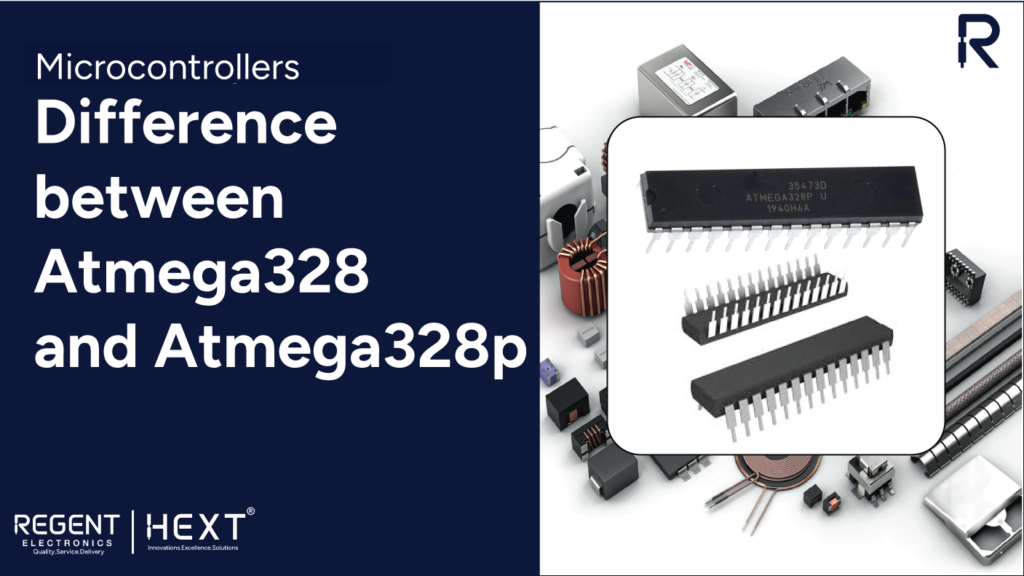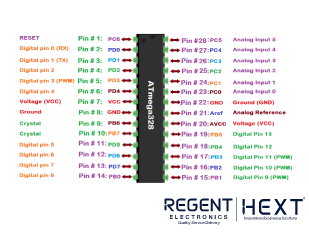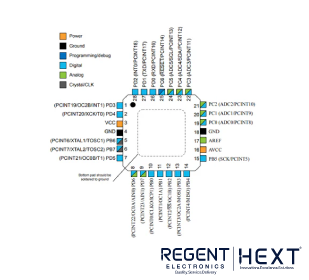
Understanding the Difference Between ATmega328 and ATmega328P: A Detailed Comparison
Introduction: ATmega328 vs ATmega328P
When selecting the right microcontroller for your Arduino projects, the ATmega328 and ATmega328P are two popular choices. While they appear very similar, there are subtle differences that may influence your decision. In this blog, we will explore the similarities and differences between these two microcontrollers to help you choose the best option for your needs.
Both the ATmega328 and ATmega328P belong to the AVR family of microcontrollers and are widely used in embedded systems, especially in Arduino boards. To make an informed choice, let’s first look at their common features before diving into the differences.
Common Features of ATmega328 and ATmega328P
The ATmega328 and ATmega328P are both 8-bit RISC (Reduced Instruction Set Computing) microcontrollers, designed with a focus on low-power consumption and high-speed operation. Here are some of the key features they share:
- Flash Memory: Both microcontrollers offer 32KB of flash memory, used to store your program code.
- EEPROM: They come with 1KB of EEPROM for non-volatile data storage.
- SRAM: Both have 2KB of SRAM, which is used for temporary data storage during operation.
- Architecture: Both microcontrollers are based on AVR architecture, providing efficient processing and a wide range of peripheral support.
- Pins: The ATmega328 and ATmega328P both have 28 pins, available in various packages, including PDIP and TQFP.

Pinout and Connectivity
Both microcontrollers feature the same pinout, which includes:
- Port B (PB0-PB7): An 8-bit bi-directional I/O port.
- Port C (PC0-PC5): A 7-bit bi-directional I/O port.
- Port D (PD0-PD7): Another 8-bit bi-directional I/O port.
- Analog Pins: 6 analog input pins (ADC channels) are available for reading analog signals.
- Reset Pin: The RESET pin (PC6) initiates a system reset when activated.
ATmega328/328P Block Diagram
Both the ATmega328 and ATmega328P feature the same internal architecture, which includes a CPU, memory (Flash, SRAM, EEPROM), peripherals (timers, ADC, UART), and interrupts. The ATmega328P can be programmed via a Serial Peripheral Interface (SPI) or Bootloader, which makes it compatible with the Arduino IDE.

Differences Between ATmega328 and ATmega328P
While the ATmega328 and ATmega328P share many similarities, there are important differences that can impact the selection for specific projects. Let’s break down the key distinctions:
- Power Consumption:
- ATmega328P: The ATmega328P is designed to be more energy-efficient and consumes less power than the ATmega328. This makes the ATmega328P a better choice for battery-powered projects where low power consumption is critical.
- ATmega328: While the ATmega328 is not as power-efficient as the P version, it is still suitable for most standard applications where power consumption is not a major concern.
- Manufacturing Process:
- ATmega328P: The ATmega328P is manufactured using a finer process technology, typically a 60nm process, allowing for smaller die size and lower power consumption.
- ATmega328: The ATmega328 is manufactured using a 90nm process, which results in slightly higher power consumption compared to the 328P.
- Package Variants:
- ATmega328P: Available in various package options, including the TQFP (Thin Quad Flat Package) for compact designs.
- ATmega328: The ATmega328 does not offer the TQFP variant, and is mainly available in PDIP (Plastic Dual In-line Package).
- Chip Signature:
- The ATmega328 and ATmega328P have different chip signatures, which may lead to compatibility issues when programming, especially if the software is reading the chip signature to detect the device. The ATmega328P features a pico power mode for enhanced power saving.
- Pico Power:
- The P in ATmega328P stands for Pico Power, indicating that the ATmega328P has lower idle power consumption and is optimized for low-power operations. This is particularly beneficial in projects where the device needs to operate for long periods without frequent recharging or battery changes.
- Software and Compatibility:
- Both the ATmega328 and ATmega328P are compatible with Arduino IDE and can be used in Arduino UNO boards, but the ATmega328P may provide better power efficiency for extended battery life in IoT applications or remote sensors.
ATmega328P vs ATmega328: Specifications
| Specification | ATmega328 | ATmega328P |
| Operating Voltage | 1.8V – 5.5V | 1.8V – 5.5V |
| Temperature Range | -40°C to 85°C | -40°C to 85°C |
| Power Consumption | Higher compared to 328P | Lower (Pico Power) |
| Package Options | PDIP, QFN | PDIP, TQFP, QFN |
| Chip Signature | Different from 328P | Unique (Pico Power) |
| Power Modes | Standard | Enhanced power-saving modes |
Conclusion: Choosing Between ATmega328 and ATmega328P
In conclusion, both the ATmega328 and ATmega328P microcontrollers are excellent choices for embedded systems and Arduino projects. However, if you’re working on battery-powered devices, low-power projects, or need a more compact package, the ATmega328P would be the better choice due to its lower power consumption and the availability of the TQFP package.
For projects where power efficiency isn’t as critical, the ATmega328 still offers a reliable and cost-effective solution.
At Regent Electronics, we provide a wide range of microcontrollers and components for your projects. Whether you choose the ATmega328 or ATmega328P, we have the tools and parts to help you bring your creations to life.Understanding the Difference Between ATmega328 and ATmega328P: A Detailed Comparison
Introduction: ATmega328 vs ATmega328P
When selecting the right microcontroller for your Arduino projects, the ATmega328 and ATmega328P are two popular choices. While they appear very similar, there are subtle differences that may influence your decision. In this blog, we will explore the similarities and differences between these two microcontrollers to help you choose the best option for your needs.

Both the ATmega328 and ATmega328P belong to the AVR family of microcontrollers and are widely used in embedded systems, especially in Arduino boards. To make an informed choice, let’s first look at their common features before diving into the differences.
Common Features of ATmega328 and ATmega328P
The ATmega328 and ATmega328P are both 8-bit RISC (Reduced Instruction Set Computing) microcontrollers, designed with a focus on low-power consumption and high-speed operation. Here are some of the key features they share:
- Flash Memory: Both microcontrollers offer 32KB of flash memory, used to store your program code.
- EEPROM: They come with 1KB of EEPROM for non-volatile data storage.
- SRAM: Both have 2KB of SRAM, which is used for temporary data storage during operation.
- Architecture: Both microcontrollers are based on AVR architecture, providing efficient processing and a wide range of peripheral support.
- Pins: The ATmega328 and ATmega328P both have 28 pins, available in various packages, including PDIP and TQFP.
Pinout and Connectivity

Both microcontrollers feature the same pinout, which includes:
- Port B (PB0-PB7): An 8-bit bi-directional I/O port.
- Port C (PC0-PC5): A 7-bit bi-directional I/O port.
- Port D (PD0-PD7): Another 8-bit bi-directional I/O port.
- Analog Pins: 6 analog input pins (ADC channels) are available for reading analog signals.
- Reset Pin: The RESET pin (PC6) initiates a system reset when activated.
ATmega328/328P Block Diagram
Both the ATmega328 and ATmega328P feature the same internal architecture, which includes a CPU, memory (Flash, SRAM, EEPROM), peripherals (timers, ADC, UART), and interrupts. The ATmega328P can be programmed via a Serial Peripheral Interface (SPI) or Bootloader, which makes it compatible with the Arduino IDE.
Differences Between ATmega328 and ATmega328P
While the ATmega328 and ATmega328P share many similarities, there are important differences that can impact the selection for specific projects. Let’s break down the key distinctions:
- Power Consumption:
- ATmega328P: The ATmega328P is designed to be more energy-efficient and consumes less power than the ATmega328. This makes the ATmega328P a better choice for battery-powered projects where low power consumption is critical.
- ATmega328: While the ATmega328 is not as power-efficient as the P version, it is still suitable for most standard applications where power consumption is not a major concern.
- Manufacturing Process:
- ATmega328P: The ATmega328P is manufactured using a finer process technology, typically a 60nm process, allowing for smaller die size and lower power consumption.
- ATmega328: The ATmega328 is manufactured using a 90nm process, which results in slightly higher power consumption compared to the 328P.
- Package Variants:
- ATmega328P: Available in various package options, including the TQFP (Thin Quad Flat Package) for compact designs.
- ATmega328: The ATmega328 does not offer the TQFP variant, and is mainly available in PDIP (Plastic Dual In-line Package).
- Chip Signature:
- The ATmega328 and ATmega328P have different chip signatures, which may lead to compatibility issues when programming, especially if the software is reading the chip signature to detect the device. The ATmega328P features a pico power mode for enhanced power saving.
- Pico Power:
- The P in ATmega328P stands for Pico Power, indicating that the ATmega328P has lower idle power consumption and is optimized for low-power operations. This is particularly beneficial in projects where the device needs to operate for long periods without frequent recharging or battery changes.
- Software and Compatibility:
- Both the ATmega328 and ATmega328P are compatible with Arduino IDE and can be used in Arduino UNO boards, but the ATmega328P may provide better power efficiency for extended battery life in IoT applications or remote sensors.
ATmega328P vs ATmega328: Specifications
| Specification | ATmega328 | ATmega328P |
| Operating Voltage | 1.8V – 5.5V | 1.8V – 5.5V |
| Temperature Range | -40°C to 85°C | -40°C to 85°C |
| Power Consumption | Higher compared to 328P | Lower (Pico Power) |
| Package Options | PDIP, QFN | PDIP, TQFP, QFN |
| Chip Signature | Different from 328P | Unique (Pico Power) |
| Power Modes | Standard | Enhanced power-saving modes |
Conclusion: Choosing Between ATmega328 and ATmega328P
In conclusion, both the ATmega328 and ATmega328P microcontrollers are excellent choices for embedded systems and Arduino projects. However, if you’re working on battery-powered devices, low-power projects, or need a more compact package, the ATmega328P would be the better choice due to its lower power consumption and the availability of the TQFP package.
For projects where power efficiency isn’t as critical, the ATmega328 still offers a reliable and cost-effective solution.
At Regent Electronics, we provide a wide range of microcontrollers and components for your projects. Whether you choose the ATmega328 or ATmega328P, we have the tools and parts to help you bring your creations to life.
